Announcing the public beta for dedicated clusters
Today we're excited to open up dedicated clusters to all our customers and some amazing new additions to our serverless Postgres platform.
Author
Alex FrancoeurDate published
Update: The offer of free credits is no longer available
Earlier this year we announced our serverless Postgres platform and an early access program for dedicated clusters. Both of these offerings are core to Xata's evolution to becoming a Postgres database platform for faster development and a worry-free data layer. Serverless Postgres unlocks decades worth of community, tooling and support for our customers. While dedicated clusters provide more predictable costs, better performance and a more scalable solution for large production workloads. The two pair perfectly together, and we'll be diving into what's new in this blog.
We're extremely excited to announce the next milestone in this evolution, our public beta for dedicated clusters 🎉
We also want to whole-heartedly thank our EAP customers for not only being early adopters, but providing amazing levels of feedback throughout the journey. Keep a look out, you'll all be receiving some premium Xata swag soon 💜
What is a dedicated cluster?
Today, most Xata databases live in a shared cell architecture. Our multi-tenant cells include a Postgres Aurora cluster, an Elasticsearch cluster, high availability built in and all the APIs and services required for development. Within each cell, we split the system for each workspace to include up to 2,000 active databases per cell before we have to spin up a new one. Unless you were an EAP customer, your Xata database is using this shared cell architecture.
Our dedicated clusters are essentially dedicated cells. So you have all the same benefits of the shared cell architecture, with less limitations caused by shared resources, more control over your infrastructure, decoupled usage based pricing and the confidence that Xata can scale with your business.
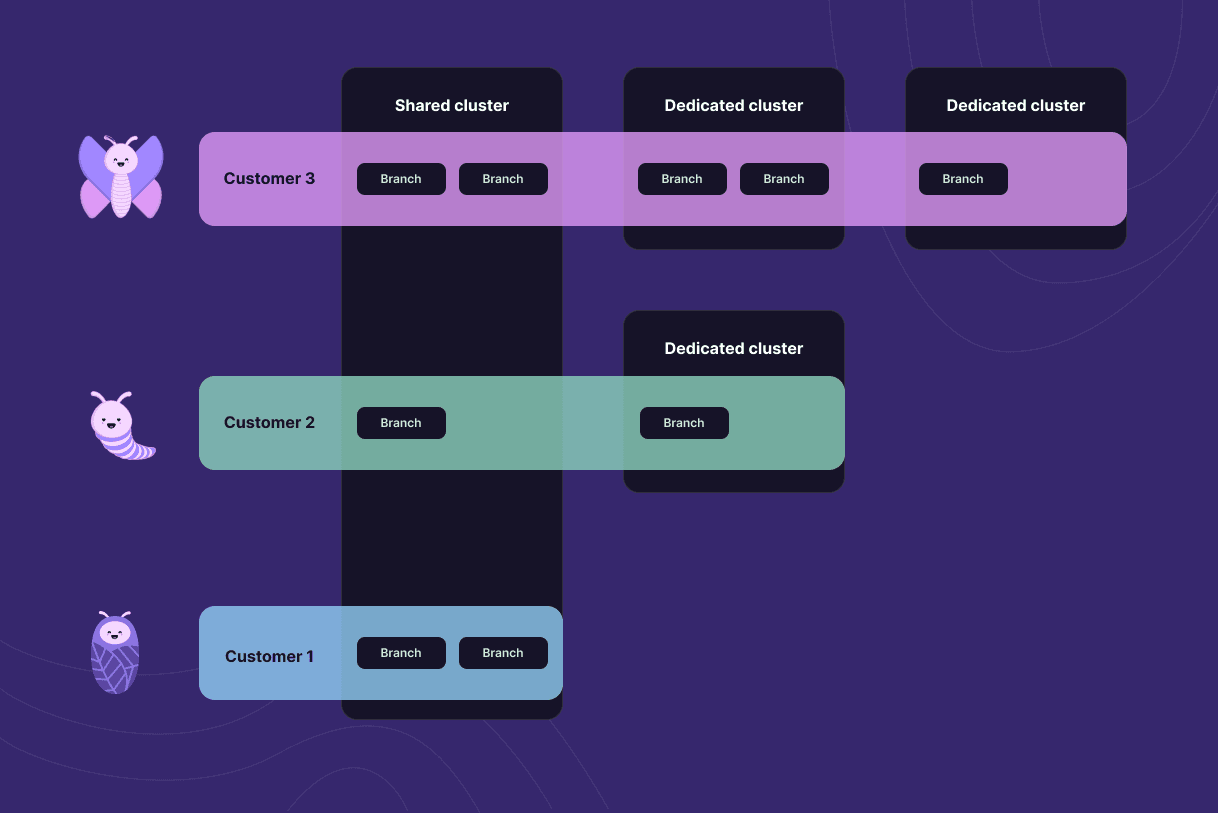
Postgres branches allocated to shared and dedicated clusters
I won't get into the weeds today, but if you're interested in learning more, this blog and our documentation are great resources.
Get started with $1,000 in credit
To kick off this launch week right and celebrate our public beta release, we will be offering $1,000 in credit for Pro customers that start using dedicated cluster between now and its general availability later this year. This credit will be valid through the end of 2025, but you will only have a few months to qualify. As a customer, you do not need to apply for the credit. Any usage from a dedicated cluster will automatically be deducted and you have full control over what the deployment looks like.
If you're already a happy Xata customer, you can easily move all of your databases or a single branch to a dedicated cluster in just a few clicks.
What's new
The team has been hard at work over the last few months building out features and functionality to provide the best experience to our beta customers. Starting today you can spin up dedicated Postgres cluster classes ranging in size from db.t4g.medium to db.r6g.2xlarge in both us-east-1 and eu-central-1. We plan to introduce more classes, versions, regions and extensions in the coming months, so please let us know what you'd like to see.
Here are just some of the many features and functionality available starting today.
Customize your infrastructure for your use case
Whether you're provisioning a new cluster or editing the one you already have, there are numerous configuration options to make sure you have the appropriate infrastructure for your use case.

Provision a new cluster
Today, our Postgres databases are Amazon Aurora instances. You can trust that your database will have the scalability, reliability and security that AWS is known for. With dedicated clusters you can configure both the Postgres engine version, cluster class and number of replicas for failover and query distribution.
Autoscaling is a great option to consider if you expect variable usage of your application and database. This will scale up or down as needed, with a simple capacity range you can define so you do not incur any unexpected costs.
Weekly maintenance windows and daily backup windows can be defined, with full control over when updates and version upgrades are applied.
Most of the configuration options we provide will impact the monthly cost, and there is a very simple estimated monthly cost presented to you before you provision the cluster.
As we look ahead, we plan to provide templates that include infrastructure and configuration best practices for specific use cases.
Visibility into usage of your cluster
Every dedicated cluster has an overview page, where you can get a sense of what the usage of your infrastructure looks like and where the bottlenecks may be occurring. This view provides visibility into CPU utilization, database connections, freeable memory, storage, receive and transmit throughput and read/write IO.
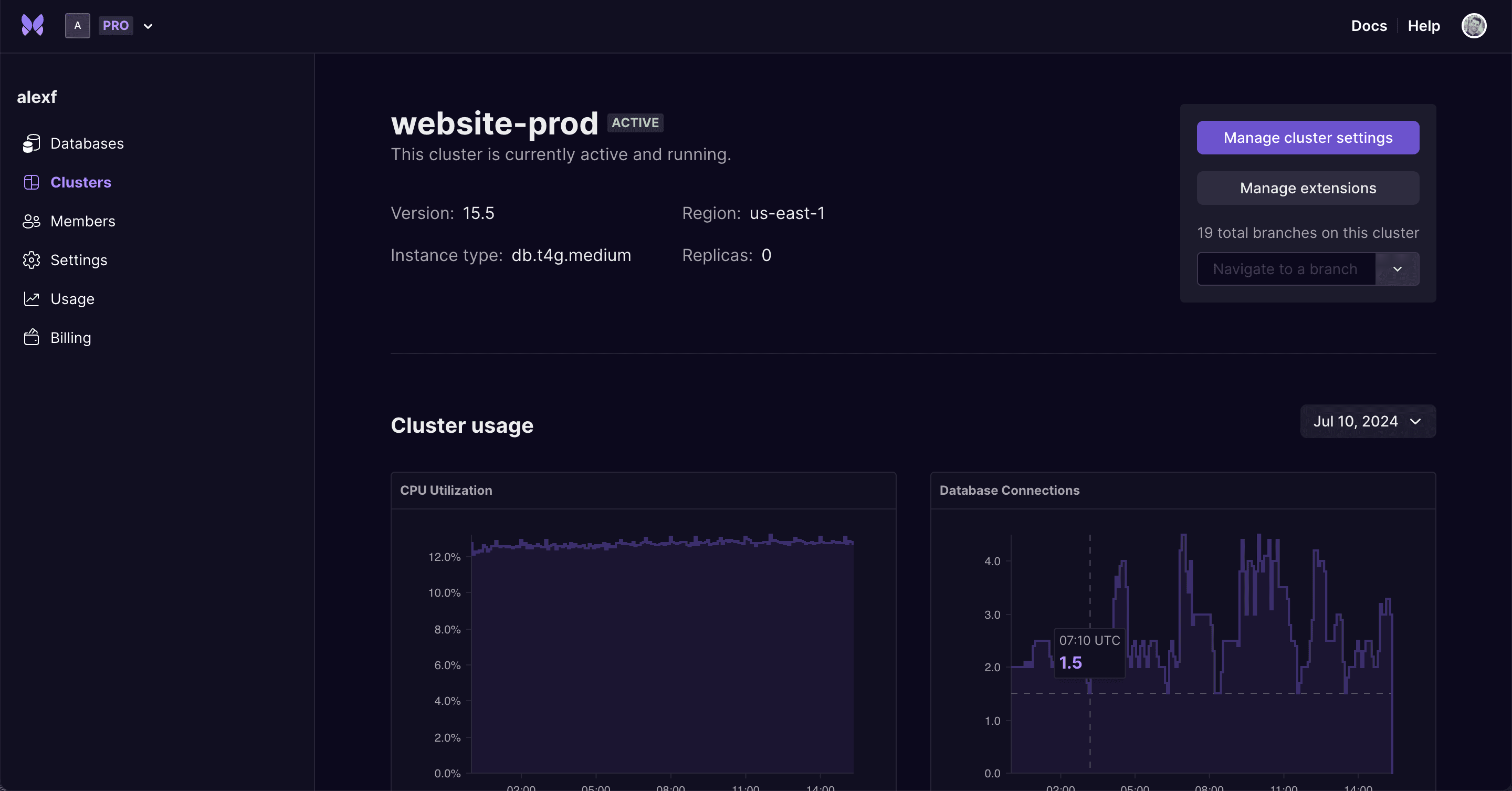
These are not only useful for monitoring usage, but will give you a sense for what the usage will cost on top of the dedicated infrastructure. For more details around the what the pricing looks like for dedicated clusters, you can look at our pricing page.
Extensions now supported
One of the drawbacks (and reasons for building dedicated clusters) is that shared clusters, while useful for most projects, have certain limitations because of the shared resources. There are simply more security precautions for every new supported piece of functionality we add. Naturally, we cannot provide the same supported extensions in shared clusters as we can in dedicated clusters.
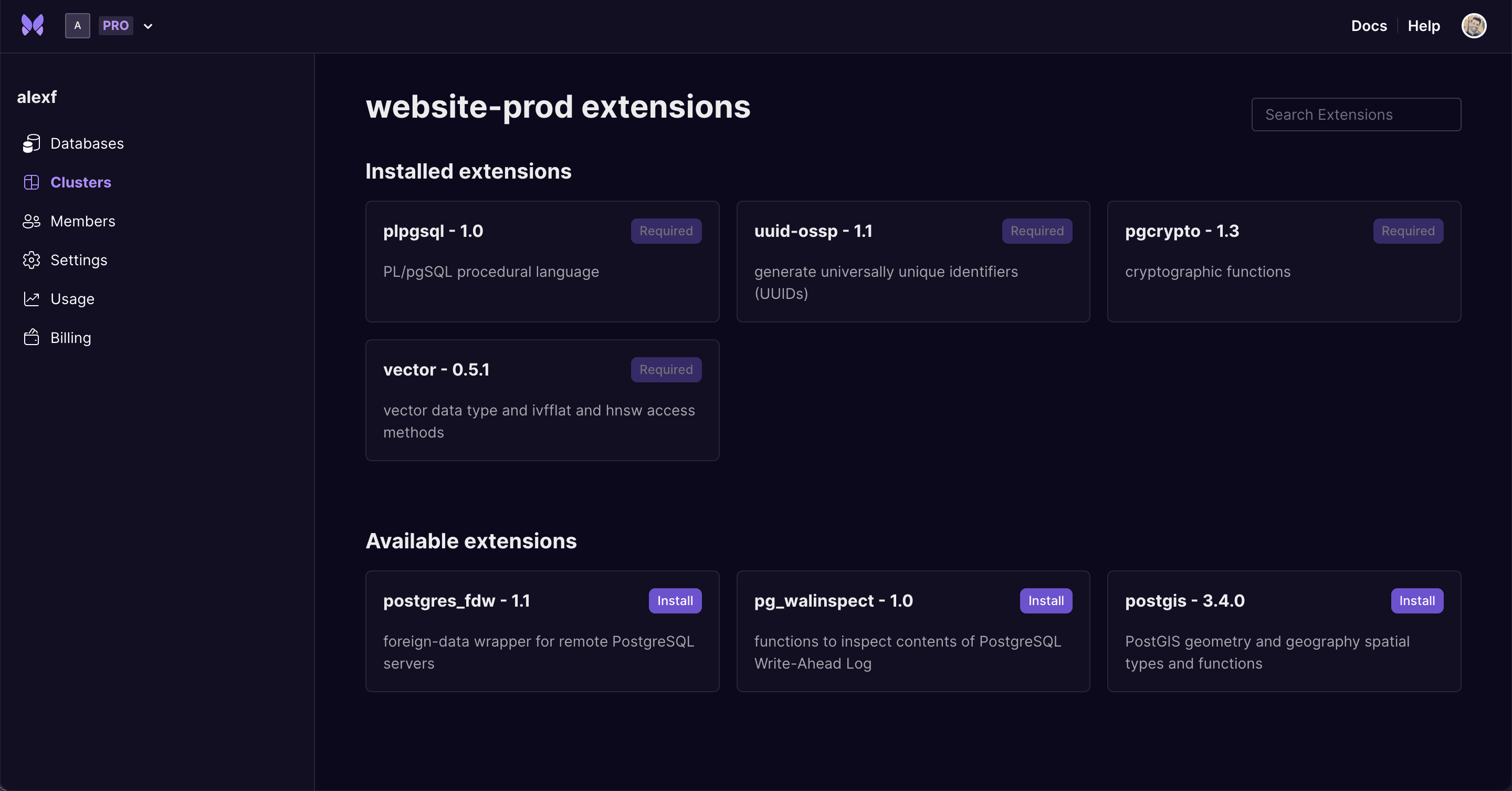
We've started adding Postgres extensions based on popularity amongst our customer base, starting with plpgsql, uuid-ossp, pgcrypto, vector, postgres_fdw, pg_walinspect and postgis. We will continue to grow this library of extensions over time, but please let us know if there's one missing you'd like to see.
Move your database and branches between clusters
One of the most powerful features that come with this beta release, is the ability to move branches between clusters. You are able to take your main database or one of its branches and move it to another cluster in just a few clicks. We are using this internally to provide a forever-free tier, automatically moving inactive databases to a special cell meant for longer term storage and moving it back to an active cell if re-activated. Our CTO, Tudor Golubenco, dives into the economics of our free tier and the technical details behind it in this blog.
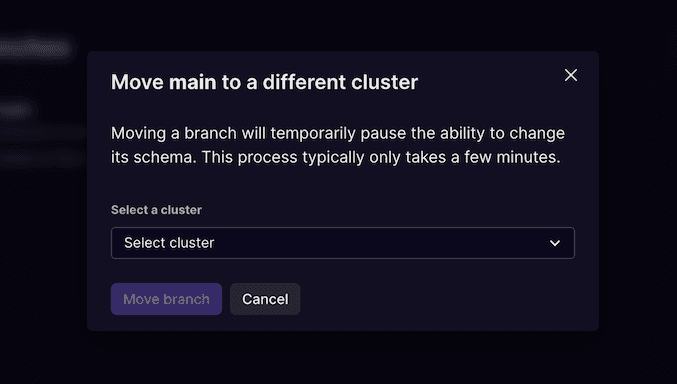
That is one internal use case for this functionality, but it opens up many possibilities for blue-green deployments, testing / developer environments and database management with zero downtime.
Complimenting the ability to move branches between clusters, you are now able to define a default cluster for your database.
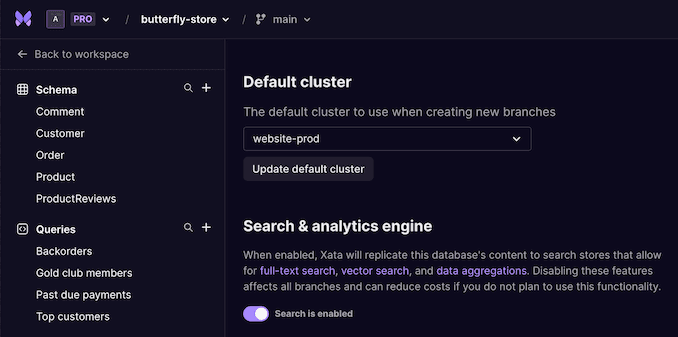
When you choose a default cluster, any new branch within that database will automatically be created there. This is perfect for development workflows that use branching for staging environments or pull request based development. Your dedicated cluster could only be for your production database, while each branch created could be automatically created in a shared cluster or a dedicated development cluster.
Stay tuned, we'll dive into some use cases and workflows that are now possible with the movement of branches later this week.
SQL, unlocked
As you'll soon seen, dedicated clusters has only been a portion of our focus since our last launch week. We've also spent time improving our Postgres offering, the tooling around it and better supporting the use cases and workflows our customers have been asking for.
Our SQL offering is built on a proxy. This approach allows us to provide the best and most secure serverless experience possible. Over the last few months, we've been heads down on making sure that our Postgres offering works with the ORMs and tooling you know and love.
Even more compatible with your favorite clients and tooling
We've put a special focus on making sure Drizzle, Prisma, SQLAlchemy and Django ORMs work well with our platform. Common administrative and data exploration tools like DataGrip, pgAdmin and TablePlus have been put through the wringer to resolve any compatibility hiccups seen over the past few months.
With our recent support for multiple Postgres schemas, and a configurable search_path, our offering is now much more compatible with a growing set of clients and tools. Our list of supported statements continues to expand, and we aim to maximize compatibility in both shared and dedicated clusters in the coming months.
Thank you to all our early adopters for providing feedback early on, we couldn't have made this progress without you 🦋
Playground has been upgraded to Queries
Outside of the table editor, the most popular part of our application is the Playground. And we've seen significant growth in this workflow for SQL queries over the past year. With this release, we're upgrading the Playground to Queries. Queries will be much more prominent in the navigation, making it really easy to pick up where you left off. You can still run TypeScript and Python code, but we've significantly improved the SQL experience.

Previously, the output had only been JSON. We now default to a table view. You can run multiple query statements at once, automatically creating tabs for each of the outputs. All queries are persisted serverside, so they're ready for re-use wherever you are.
This is just the beginning for Queries. We plan to do much more here. Providing a table output with full feature parity to the editor, the ability to favorite or pin queries and eventually, make them shareable between users in (and outside of) your workspace. Keep on eye on this view, we'll be incrementally improving over time. If you have a specific feature request, feel free to drop it in here.
Join in on the fun this week
Want to see dedicated clusters in action? Check out this quick demo video.
If you haven't tried out our serverless Postgres offering yet, it's really easy to get started. Simply sign up for Xata, use pg_dump to export your existing database and pg_restore to import into Xata.
You can follow along this week with a new announcement every day on our launch week page, join in on our summer hackathon or just pop into Discord and say hi 👋
However you choose to participate, thank you for your support and we can't wait to see what you build 🦋
Related Posts
Introducing Dedicated Clusters for PostgreSQL
We are announcing dedicated clusters, for more scalable and isolated PostgreSQL databases.